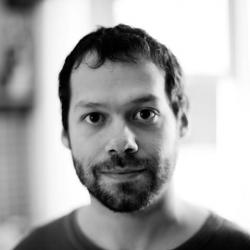Le Naufrage: A Mariner’s Tale
Click above photo for slideshow (34 images)
A Mariner’s Tale:
‘Le Naufrage’ explores heritage of Canada’s
first settlers through pictures of life at sea
True North Photo Journal: Can you tell me about your photos?
Charles-Frédérick Ouellet: Over the past few years, I have been investigating the particular energy that surrounds communities that have settled along the sea. I examine the sea as an active element, with the view that its constant motion and dazzling power leaves marks on people and places alike. In Le Naufrage, I recount life at sea along the coast of the oldest water ways of North America: the St. Lawrence River. The series moves from raw depictions to dreamlike impressions, looking for situations in which human and nature cohabit together.
TNPJ: Why were you drawn to this story?
C.O: I was drawn to the fisherman at first, because I wanted to talk more generally about the land and history of where I was born. We come from a land which was discovered and explored through its water ways and this is something I investigate through my projects. The first contacts between First Nations people and Europeans were made by fishermen long before Jacques Cartier claimed the land. For me, in this body of work, the figure of the fisherman represents our origin. In Quebec, our society was born from the sea, dependant from the Saint-Lawrence river, for supply, to communicate and to move to one place to an other.
The river was a reality imposed to the inhabitants. After a moment photographing at sea, I thought I should try to get out of the boat to photograph the coastline. I was looking for areas relevant to the subject, photographing places where the fishermen communities had settled down as well as shipwreck sites. I’m fascinated by history, and navigation on the Saint-Lawrence river is part of our maritime heritage. By photographing shipwreck sites along the coastline, I was adding the dimension of time to the project, linking past and present together.
TNPJ: Tell me more about the people in the photographs?
C.O: What you see in the project are images taken mostly aboard snow crab and shrimp fishing vessels. I would go on different trips every year with fishermen I’d find on my way along the Gaspesie coastline. I have plenty of different stories to tell, but one thing that always struck me, was the fishermen’s ability to read the seascape. For people living on the land, the seascape is pretty much the horizon line, but when you live at sea you start seeing the elements. I was interested to represent those elements in the project; by photographing the wind, the clouds and the sea, I added another perspective to the narrative.
TNPJ: When did you make these pictures?
C.O: The pictures were made between 2010 and 2016. I’m actually working on the book which should come out somewhere this autumn. Le Naufrage will be published by Les Editions du Renard, a photobook publisher from Montreal city.
TNPJ: What was it like being out on the water when you were working?
C.O: Well some of the crab fishing boats are quite small, so being up close in the photographs is just rendering what it is to live and work on one of these boats. As you probably know, fishermen are usually men of few words, but they are really welcoming people too. I always tried to help as much as possible on the boat but there were usually enough men on the deck for the job.
TNPJ:Was it hard to keep your gear from getting beat up on the water?
C.O: Well, all your gear end up rusty after a trip because of the salt water and the iodine, but that’s just part of the deal.
TNPJ:What do you hope people will take away from your story?
C.O: That’s a hard to say. My aim was always to create a document that is more immersive than factual. I like to explore the thin line between archive documents and contemporary scenes. Most of the images from the project translate a timeless feel and that’s what I was after in order to bring past and present together. I’m not really interested in illustrating facts or situations. Rather, I suggest or try to translate trough photography. I just hope people will look at the project as a different way to explore our history.


